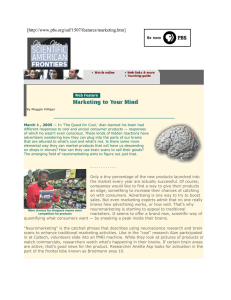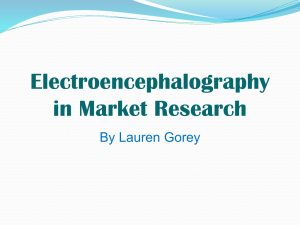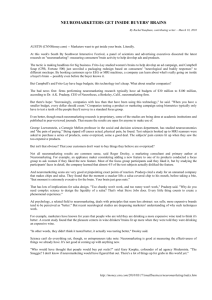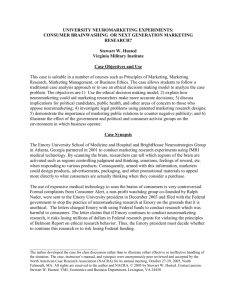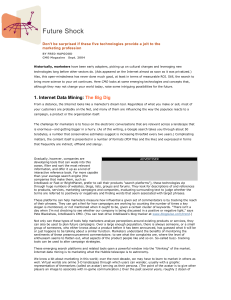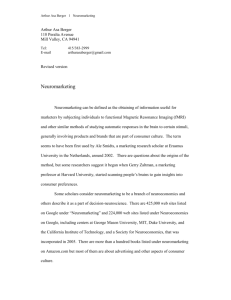Brain Scans and Mark..
advertisement
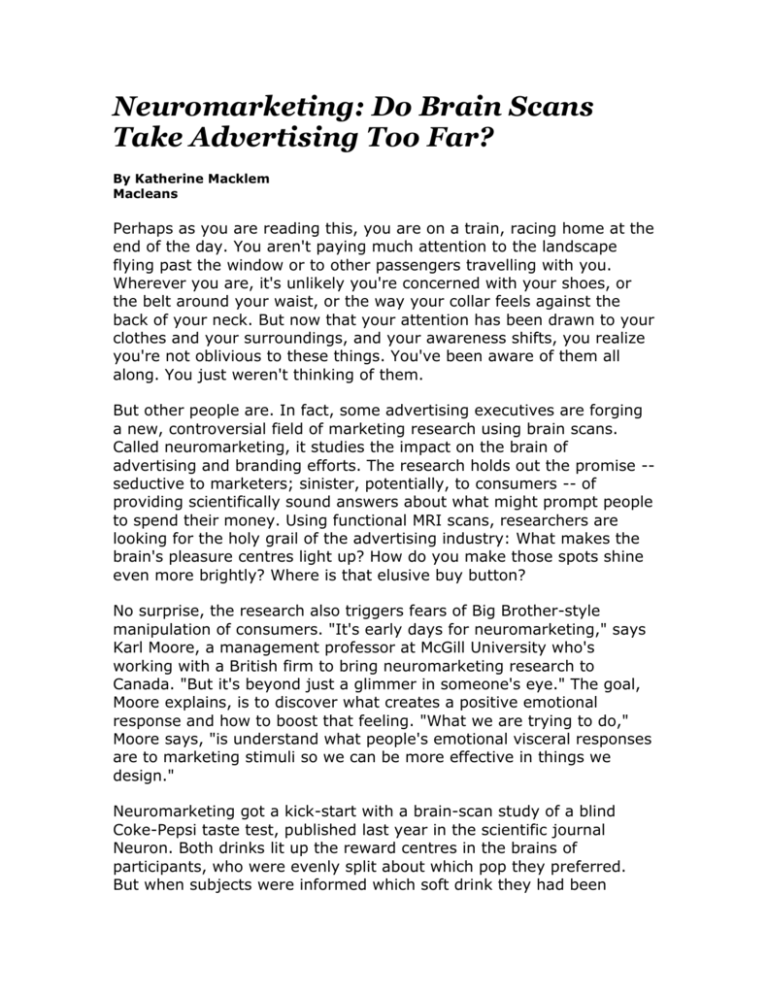
Neuromarketing: Do Brain Scans Take Advertising Too Far? By Katherine Macklem Macleans Perhaps as you are reading this, you are on a train, racing home at the end of the day. You aren't paying much attention to the landscape flying past the window or to other passengers travelling with you. Wherever you are, it's unlikely you're concerned with your shoes, or the belt around your waist, or the way your collar feels against the back of your neck. But now that your attention has been drawn to your clothes and your surroundings, and your awareness shifts, you realize you're not oblivious to these things. You've been aware of them all along. You just weren't thinking of them. But other people are. In fact, some advertising executives are forging a new, controversial field of marketing research using brain scans. Called neuromarketing, it studies the impact on the brain of advertising and branding efforts. The research holds out the promise -seductive to marketers; sinister, potentially, to consumers -- of providing scientifically sound answers about what might prompt people to spend their money. Using functional MRI scans, researchers are looking for the holy grail of the advertising industry: What makes the brain's pleasure centres light up? How do you make those spots shine even more brightly? Where is that elusive buy button? No surprise, the research also triggers fears of Big Brother-style manipulation of consumers. "It's early days for neuromarketing," says Karl Moore, a management professor at McGill University who's working with a British firm to bring neuromarketing research to Canada. "But it's beyond just a glimmer in someone's eye." The goal, Moore explains, is to discover what creates a positive emotional response and how to boost that feeling. "What we are trying to do," Moore says, "is understand what people's emotional visceral responses are to marketing stimuli so we can be more effective in things we design." Neuromarketing got a kick-start with a brain-scan study of a blind Coke-Pepsi taste test, published last year in the scientific journal Neuron. Both drinks lit up the reward centres in the brains of participants, who were evenly split about which pop they preferred. But when subjects were informed which soft drink they had been given, their brains registered activity in a new region, and three quarters of them said they preferred Coke. "This demonstrates in a fairly dramatic way that brand matters," Moore states. Moore's partner in Britain is Gemma Calvert, a founder and director of Oxford-based Neurosense Ltd. who recently conducted an experiment that tracked what the brain pays attention to while the mind is otherwise occupied. As their brains were scanned, subjects were shown hundreds of images. Later, selected images were inserted into a new series. Subjects were then asked to pick out from the second series the slides they had already seen. Based on the activity picked up by the brain scans, Calvert was able to predict which images subjects would remember, even among those who claimed they couldn't recall any images. Even these forgetful participants, instructed to just guess which ones they'd already seen, were able to select images at a rate well above random chance, Calvert says. Without the subjects realizing it, their brains were sorting and sifting -- and retaining -- information. "Experiments that let you see what the brain is picking up without the person being aware of it are extremely informative," Calvert says. "This would be very useful to predict which of many package designs or advertising boards people will recall." In another experiment, Calvert recorded brain activity in response to smell and colour. As the scent of strawberries was wafted under subjects' noses, Calvert noted the area of the brain that lit up. Then, as subjects smelled the strawberries, they were shown a screen infused with a strawberry-red colour and, lo and behold, the activity in the brain intensified dramatically. The next step was to replace the red screen with a blue one -- "you probably wouldn't eat blue strawberries," Calvert points out -- and the brain activity dropped to a level even lower than when the smell was alone. "The total of your senses is greater than the sum of its parts," Calvert concludes. "This is something the food industry is very interested in." PHD Media, which plans and buys advertising for clients, recently wrapped up research with Calvert's group into how different media impact the brain -- and which are best at delivering what types of messages. Subjects were exposed to audio ads, a combination of audio and visual ads, and just visual ads as their brains were scanned. Out of its research, PHD has created a tool that helps ad planners choose the most appropriate communication model. While the company is holding its cards close to the chest -- its research is proprietary -- it says its clients take the research seriously. As a result of the scanning studies, one client, which PHD declined to name, has changed its advertising strategy. Because PHD found that audio-visual ads were, according to the brain scans, best at disrupting existing perceptions, the client, which wanted to change people's attitudes about its services, dropped its print ads and developed a campaign for TV. "It's certainly leading edge stuff," says Fred Auchterlonie, a senior vice president working in PHD's Toronto office. "We used to joke in this business that it's not rocket science. Now, we say it's just brain surgery." This research is still too nascent to be a threat yet, but frightening possibilities are easy to imagine. The ever-crusading Ralph Nader and his organization, Commercial Alert, see ominous, Orwellian issues with neuromarketing, which it says could be used in a way that would damage public health, if adopted by tobacco or junk-food vendors, or could contribute to political propaganda exploited by extremists. In a letter to the chairman of the U.S. Senate commerce committee urging an investigation, Commercial Alert's executive director Gary Ruskin poses this question: "What would happen in this country if corporate marketers and political consultants could literally peer inside our brains?" On its website, the group warns: "Neuromarketing uses medical technologies not to heal, but to sell products." So far, neuromarketing is too clumsy to be dangerous, says George Loewenstein, a professor at Carnegie Mellon University in Pittsburgh who studies the psychology of economics and law. Loewenstein, who also uses brain scans for his research, has studied how people make short- and long-term decisions about money. The limitations of the scanning technology mean the information garnered is fuzzy, he says, and the scanning instrument itself restricts the sort of tasks subjects can do and the studies that can be run. Interpreting the results of scans in response to marketing efforts "is not that far removed from reading tea leaves," Loewenstein says. "Both the current yield for businesses and the sinister aspect of neuromarketing," he adds, "are being vastly exaggerated and overestimated by people who don't know the limitations of the technology." Still, neuromarketing is likely to stick around. In a world that craves certainty, neuromarketing research holds the promise of ads grounded more in science than in art. Now, focus groups are used to vet campaigns -- and people are known to lie in focus groups. Not on purpose, but subjects tend to say what they think group leaders want to hear, because people are naturally inclined to be agreeable. The brain scan, on the other hand, doesn't fudge the truth. Instead, neuromarketing might reassure advertising execs that their ad campaigns really do push the right buttons. "It costs so much money to create communication products and services," says Alan Middleton, a marketing professor at Toronto's York University and a former advertising executive. "The more you can manage your risk by having some sense of how a package will function is an opportunity to save a huge amount of money." If it works, it'll make huge amounts of money, too.
